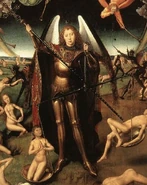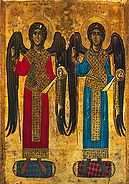Victory of Archangel Michael by Raphael, 16th century.
Archangel Michael is referred to in the Old Testament and has been part of Christian teachings since the earliest times.[1] However, throughout the centuries specific Roman Catholic traditions and views on Archangel Michael (also called "Saint Michael" by Catholics) have taken shape, as recently as the 19th and 20th centuries. For instance, a specific Prayer to Saint Michael was promoted by Pope Leo XIII in 1888 and as recently as 1994 was reinforced by Pope John Paul II who encouraged the Catholic faithful to continue to pray it, saying: "I ask everyone not to forget it and to recite it to obtain help in the battle against forces of darkness.”[2][3][4]
Archangel Michael has specific roles within Roman Catholic teachings that range from acting as the chief opponent of Satan to the saving of souls at the hour of death. Roman Catholic literature and traditions continue to point to Saint Michael in contexts as varied as the protection of the Catholic Church to the Consecration of Russia by popes Pius XII and John Paul II regarding the messages reported at Our Lady of Fatima. This article reviews these Roman Catholic teachings and traditions.
The Archangels[]
Archangel Michael with archangels Raphael and Gabriel, as they accompany Tobias, by Francesco Botticini, 1470.
Angels in general, and archangels in particular, have specific roles within Roman Catholic teachings. The Catechism of the Catholic Church (334-335) states that:[5]
"The whole life of the church benefits from the mysterious and powerful help of the angels.... From its beginning until death, human life is surrounded by their watchful care and intercession."
Roman Catholic tradition calls Michael, Gabriel and Raphael archangels. Michael means "Who is like God", Gabriel means "Power of God" and Raphael means "God heals".[6] Michael and Gabriel are named in the Bible as angels, but Raphael only appears in the Book of Tobit which is considered canonical by Roman Catholics.
Only Michael is called an archangel in the Bible. The original meaning of the name Michael gave rise to the Latin phrase Quis ut Deus? which can be seen on his artistic portrayals when he rhetorically and scornfully asks Who is like God? as he slays Satan.[7][8]
The feast of these angels is celebrated on September 29. Within the hierarchy of the angels, at the highest level, St. Michael is a princely Seraph.[9] The word archangel comes from the Greek words arche (prince) and angelos (messenger). The prophet Daniel (12: 1) called him "Michael the great prince who shall rise at the time of the end."[10]
Christian art often portrays archangels together. For instance Archangels Michael and Gabriel are jointly depicted on Our Lady of Perpetual Help, a Byzantine icon of the Blessed Virgin Mary that is has been the subject of widespread Catholic devotions for centuries.
Role and Mission[]
In Roman Catholicism Saint Michael has four distinct roles. First, he is the supreme enemy of Satan and the fallen angels. He vanquished Satan and ejected him from Paradise and will achieve victory at the hour of the final battle with Satan. Secondly, he is the Christian angel of death: at the hour of death, Saint Michael descends and gives each soul the chance to redeem itself before passing, thus consternating the devil and his minions. Saint Michael's third role is weighing souls in his perfectly balanced scales (hence the saint is often depicted holding scales) on Judgment Day. And finally, Saint Michael is the Guardian of the Church.[11]
In the Catholic tradition, Saint Michael symbolizes the victory of good over evil, and he has been widely represented in Catholic art through the ages. Devotions to Saint Michael have a large Catholic following, and a large number of churches are dedicated to him worldwide.
Defeat of the Adversary and the Fallen angels[]
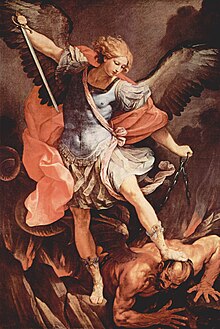
Guido Reni's painting in Santa Maria della Concezione, Rome, 1636 is also reproduced in mosaic at the St. Michael Altar in St. Peter's Basilica, in the Vatican.[12]
In Catholic teachings, Saint Michael is viewed as the leader of the army of God. From the time of the apostles, he has been invoked and honored as the protector of the Church. Scripture describes him as "one of the chief princes" and the leader of Heaven's forces in their triumph over the powers of hell.[13]
Saint Michael defeats Satan twice, first when he ejects Satan from Paradise, and then in the final battle of the end times. In his classic book Lives of the Saints, priest and hagiographer Alban Butler, defined the role of Saint Michael as follows:[14]
"Who is like God?" was the cry of Archangel Michael when he smote the rebel Lucifer in the conflict of the heavenly hosts. And when Antichrist shall have set up his kingdom on earth, it is St Michael who will unfurl once more the standard of the cross, sound the last trumpet, bind together the false prophet and the beast and hurl them for all eternity into the burning pool.
It was Saint Michael who vanquished Satan and drove him out of Heaven. In the Book of Revelation (Rev 12:7-9) Saint John wrote of Archangel Michael's role in the War in Heaven where he hurls Satan and the Fallen angels out of heaven to earth:[15]
"And there was war in heaven. Michael and his angels fought against the dragon, and the dragon and his angels fought back. But he was not strong enough, and they lost their place in heaven. The great dragon was hurled down — that ancient serpent called the devil, or Satan, who leads the whole world astray. He was hurled to the earth, and his angels with him."
Depictions of Saint Michael often portray the scene where Satan, or the fallen angels, are helplessly below the sword or spear of a triumphant Saint Michael whose face often displays intense concentration.[16] In some depictions, the Latin phrase Quis ut Deus? can be seen on the shield of Saint Michael. The phrase means "Who is like God?" and Saint Michael asks it scornfully as he slays Satan, represented as a dragon, or a man-like figure, at times with wings.[17][18]
In Catholic teachings, Saint Michael will also triumph at the end times when Antichrist will be defeated by him.[19] In the Bible, The Book of Daniel states:[20]
"At that time Michael, the great prince who protects your people, will arise. There will be a time of distress such as has not happened from the beginning of nations until then. But at that time your people - everyone whose name is found written in the book - will be delivered.
In the Roman Catholic tradition, Saint Michael is the angelic model for the virtues of the spiritual warrior, a paradigm extended to other warrior saints. The conflict against evil may at times be viewed as the battle within. It requires great courage and forebearance to step onto the inner battlefield and strike down whatever internal demons stand on the way to sanctity. The concept of the warrior saint has extended to other Catholic saints, beginning with examples such as Saint George and Saint Theodore of Amasea.[21]
Saving souls at the hour of death[]
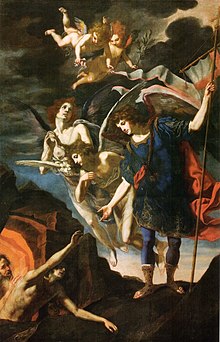
Archangel Michael reaching to save souls near death, by Jacopo Vignali, 17th century.
In Roman Catholic teachings, Saint Michael is one of the angels who are assumed present at the hour of a person's death. In his role as the patron of holy souls, Archangel Michael reaches to souls near death and saves them, hence frustrating Satan. Traditionally, he is charged to assist the dying and accompany their souls to their private judgment, bring them to purgatory and afterwards, present them to God at their entrance to Heaven.
This is the reason for dedicating cemetery chapels to him, and all over Europe thousands of such chapels bear his name, and at times weekly masses are offered in his honor and in favor of the departed ones in these chapels.[22]
This role of Saint Michael as the guardian of the souls to be redeemed is also reflected in Catholic prayers to the saint, e.g.:[23]
The Holy House of God venerates you
as her guardian and protector;
to you the Lord has entrusted
the souls of the redeemed
to be led into Paradise.
Weighing souls on Judgment Day[]
In Catholic teachings, on Judgment Day Saint Michael weighs souls based on their deeds during their life on earth. Saint Michael is often portrayed in art with scales as he weighs souls.[24]
This aspect of Saint Michael's duties is portrayed in Roman Catholic poetry devoted to him, e.g.:[25]
"That you will gather the souls of the righteous and the wicked,
place us on your great scales and weigh our deeds.
That if we have been loving and kind, you will take the key from around
our neck and open the gates of Paradise, inviting us to live there for ever.
And that if we have been selfish and cruel, it is you who will banish us."
This role of Archangel Michael was depicted by Michaelangelo on the ceiling of the Sistine Chapel in the Vatican. In this depiction, angels hold up two books: the smaller book held by Archangel Michael records the names of the blessed, while the larger book is a list of the damned.[26]
Guardian of the Church[]
Archangel Michael statue Kiev, Ukraine.
The Catholic tradition has for long recognised Saint Michael as the protector and guardian of the Church itself and the angel of the Blessed Sacrament. Saint Michael is also the guardian angel of the Pope and has been invoked as the patron and guardian angel of many countries as well as specific professions.[27][28]
The role of Saint Michael as protector and guardian has also led to the design of statues that depict him and the construction of Churches and monasteries at specific locations. Because most monastic islands lie close to land, they were viewed as forts holding demons at a distance against attacks on the Church. Monasteries such as Mont St. Michel off the coast of Normandy, France and Skellig Michael, off the coast of County Kerry, Ireland, dedicated to the Archangel are examples of these.[29]

St. Michael's church in Hammerfest, Norway, the Northernmost Catholic church in the world.
A large number of Catholic churches around the globe are dedicated to Archangel Michael, from Hammerfest, Norway to Oeste Catarinense in Brazil. Saint Michael's feast day of September 29 has been solemnly celebrated in many locations since the fifth century. And many churches that honor Saint Michael are dedicated on the 29th of September, e.g. in 610 Pope Boniface IV dedicated Saint Michael's Church in Rome, on that day.[30]
In Catholic teachings, the guarding of the Church and its principles, is viewed as an ongoing battle against Satan's deceit, with Saint Michael coming to the aid of the faithful when he is called on. Specific Catholic prayers and Novenas to the saint call on him for protection. The role of the guardian and protector of the Church (viewed as Christ's House) is reflected in Catholic prayers to Saint Michael, e.g."[31]
Glorious Saint Michael,
guardian and defender of Christ's House,
come to the assistance of His followers,
against whom the powers of hell are unchained.
Views of the saints and the popes[]
Archangel Michael by Jaime Huguet, 1456.
St. Francis of Assisi was specially devoted to Archangel Michael and often said that Saint Michael should be specially honored because his duty is presenting souls to God. St. Francis used to say that: "Each person should offer God some special praise or gift in honor of such a great prince" and he would fast for about forty days from the feast of the Assumption (August 15) to Saint Michael's feast day on September 29.[32]
St. Bernard of Clairvaux recommended the invocation of Saint Michael at the time of temptation and sorrow. He said:[14]
"Whenever any grievous temptation or vehement sorrow oppresses thee, invoke thy guardian, thy leader, cry out to him, and say, Lord, save us, lest we perish!"
In his 1986 address called "Angels Participate in the History of Salvation" Pope John Paul II emphasized the role of the Archangels and stated that:"the angels who participate in the life of the Trinity in the light of glory are also called to play their part in the history of human salvation, in the moments established by divine Providence".[33]
In 2007, Pope Benedict XVI described part of the role of Saint Michael as follows:[34]
"...defends the cause of God's oneness against the presumption of the dragon, the "ancient serpent", as John calls it. The serpent's continuous effort is to make men believe that God must disappear so that they themselves may become important; that God impedes our freedom and, therefore, that we must rid ourselves of him."
In this address Pope Benedict XVI urged all bishops to act as part of the army of Saint Michael against evil.
Prayers and devotions[]
Roman Catholic Devotions to Saint Michael have been expressed in a variety of forms. Given that "the Rosary and scapular are the badges of the devout Catholic" the saint has his own chaplet and scapular.[35] And a number of prayers, Novenas and hymns are devoted to him.
Prayers and Novenas[]
The Prayer to Saint Michael specifically asks for Catholics to be "defended in the day of battle", referring to the battle against evil in which Saint Michael defeats Satan. This prayer was added to the Leonine Prayers by Pope Leo XIII in 1888.[36][37][38]
While the usual Prayer to Saint Michael, on the left below, is one of the best known angelic prayers in the Catholic tradition, there are other prayers, e.g. the one on the right:
|
Saint Michael the Archangel, |
O glorious prince St. Michael, |
The Novenas to Saint Michael are prayed on nine consecutive days, as any other Novena.
Chaplet[]
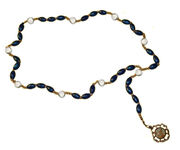
A Saint Michael Chaplet using beads like a Rosary.
The Chaplet of St. Michael is a Chaplet attributed to a private revelation by Saint Michael to the Carmelite nun Antonia d'Astonac in 1751. The chaplet was approved by Pope Pius IX in 1851, and was granted indulgences.[39][40]
The chaplet consists of nine salutations, one for each choir of angels. An Our Father and three Hail Marys are said on each decade. It concludes with four Our Fathers, honoring Saints Michael, Gabriel, Raphael and the Guardian Angel. The chaplet is begun with an act of contrition and is concluded with a prayer to Saint Michael. It is said to provide great benefits for those who pray it often, among those: the continuous assistance from Saint Michael the Archangel and the company of one angel of each of the nine celestial choirs when approaching communion.
Scapular[]
The Scapular of St. Michael the Archangel is a Roman Catholic devotional scapular associated with St. Michael, the Archangel. Pope Pius IX gave this scapular his blessing, but it was first formally approved under Pope Leo XIII who sanctioned the Archconfraternity of the Scapular of St. Michael. Indulgences were approved by the Congregation of Indulgences in 1903. Each member of the confraternity is invested with the scapular.
The form of this scapular is somewhat distinct, in that the two segments of cloth that constitute it have the form of a small shield; one is made of blue and the other of black cloth, and one of the bands likewise is blue and the other black. Both portions of the scapular bear the well-known representation of the Archangel St. Michael slaying the dragon and the inscription "Quis ut Deus?" meaning Who is like God?.[41]
Archangel Michael defeating Satan by Carlo Crivelli, 15th century.
Exorcism[]
The Prayer to Saint Michael is part of the Roman Catholic Ritual and can be used as part of the Roman Catholic practice of exorcism, along with other formulas such as Vade Retro Satana, whose 17th century re-discovery was at the Benedictine Metten Abbey dedicated to Saint Michael.[42][43]
Hymns[]
Through the centuries, Catholic devotions to Saint Michael have resulted in a number of poems and hymns. [44][45][46]
An example is the Hymn to Archangel Michael:
O angel! Bear, O Michael of great miracles, To the Lord my plaint.
Hearest thou? Ask of forgiving God Forgiveness of all my vast evil.
Delay not! Carry my fervent prayer To the King, the great King!
To my soul Bring help, bring comfort At the hour of its leaving earth.
Stoutly To meet my expectant soul Come with many thousand angels!
O Soldier! Against the crooked, wicked, militant world Come to my help in earnest!
Do not Disdain what I say! As long as I live do not desert me!
Thee I choose, That thou mayst save my soul, My mind, my sense, my body.
O thou of goodly counsels, Victorious, triumphant one, Angelic slayer of Antichrist!
The hymn "Te Splendor" to Saint Michael (which derives its name from the fact that in Latin it begins with Te splendor et virtus Patris) is published in the Raccolta collection of prayers with indulgences. In 1817 Pope Pius VII granted an indulgences for saying the hymn with a contrite heart and devotion, in honor of Saint Michael to obtain his patronage and protection against the assaults of the enemy of man.[47]
Apparitions[]

Archangel Michael in Victory, by Simon Ushakov, 1676.
Legends include a number of reported appearances of Saint Michael, where sanctuaries or churches were later built or dedicated to him. These include Monte Gargano in Italy early in the 6th century, where the Sanctuary of Monte Sant'Angelo, the oldest shrine in Western Europe is dedicated to Saint Michael. Pope Gregory I the Great also reported visions of Saint Michael early in the 7th century and to honor the occasion, Castel Sant'Angelo (Castle of the Holy Angel) in Rome was named after him.[48][49]
Early in the 8th century, Saint Michael reportedly appeared three times to St. Aubert, the bishop of Avranches in Normandy, France and instructed him to build a church on the small island now known as Mont Saint Michel. Several healings were reported when the church was being built and Mont Saint Michel still remains a Catholic pilgrimage site.[50][51]
In 1751, the Carmelite nun Antonia d'Astonac reported a private revelation by Saint Michael in which she received the Chaplet of Saint Michael. The chaplet was later approved by Pope Pius IX in 1851.[39]
An apparition of Saint Michael was reported to have preceded the Garabandal Marian apparitions to four young schoolgirls in the village of Garabandal in northwest Spain, from 1961 to 1965. In this apparition, Saint Michael reportedly delivered a message to announce the arrival of the Blessed Virgin Mary.[52]
Given that some of the Our Lady of Fatima messages have been linked by the Holy See to the "end times",[53] some Catholic authors have concluded that the angel with the flaming sword referred to within the Fatima messages is Archangel Michael who defeats Satan.[54][55][56] Author Timothy Robertson takes the position that the Consecration of Russia by popes Pius XII and John Paul II was a step in the eventual defeat of Satan by the Archangel Michael.[57]
Art and architecture[]
Paintings[]
- For a larger gallery of paintings and statues, please see: Saint Michael paintings gallery.
Icons[]
- For a larger gallery of icons, please see: Saint Michael icons gallery.
Statues[]
- For a larger gallery of paintings and statues, please see: Saint Michael statues gallery.
Churches[]
- For a list of churches dedicated to Saint Michael, please see: St. Michael's Church and St. Michael's Cathedral.
- For a larger gallery of church images, please see: Saint Michael church gallery.
Altars[]
References[]
- ↑ John Norman Kelly, Early Christian Doctrines Continuum Publishing, 2000 ISBN 0826452523 page 7
- ↑ James White, Roman Catholic Worship Liturgical Press, 2003 ISBN 0814661947, page 87
- ↑ Vatican website: Regina Coeli 1994
- ↑ EWTN on Saint Michael [1]
- ↑ Catechism of the Catholic Church David Bordwell, the Vatican, Continuum International Publishing, 2002 ISBN 0860123243, page 78
- ↑ Ann Ball, 2003, Encyclopedia of Catholic Devotions and Practices OSV Press ISBN 087973910X page 42
- ↑ Ann Ball, 2003 Encyclopedia of Catholic Devotions and Practices ISBN 087973910X page 520
- ↑ Catholic Encyclopedia [2]
- ↑ OSV's Catholic Encyclopedia By Peter M. J. Stravinskas, OSV Publishing, 1998 ISBN 0879736690 page 100
- ↑ Bible gateway
- ↑ Donna-Marie O'Boyle, Catholic Saints Prayer Book OSV Publishing, 2008 ISBN 1592762859 page 61
- ↑ Catholic encyclopedia
- ↑ Donna-Marie O'Boyle, Catholic Saints Prayer Book OSV Publishing, 2008 ISBN 1592762859 page 60
- ↑ 14.0 14.1 Alban Butler, Lives of the Saints Published by Forgotten Books ISBN 1605063126 page 372
- ↑ Bible gateway
- ↑ Solrunn Nes, The mystical language of icons, Eerdmans Publishing, 2005 ISBN 0802829163, page 91
- ↑ John Elven, 1854, The book of family crests Henry Washbourne Publisher, page 112
- ↑ Catholic Encyclopedia
- ↑ Catholic encyclopedia
- ↑ Bible gateway, Daniel 12:1
- ↑ Mirabai Starr, Saint Michael: The Archangel, Published by Sounds True, 2007 ISBN 159179627X page 2
- ↑ Ann Ball, 2003, Encyclopedia of Catholic Devotions and Practices OSV Press ISBN 087973910X pages 42 and 425
- ↑ Mirabai Starr, Saint Michael: The Archangel, Published by Sounds True, 2007 ISBN 159179627X page 39
- ↑ Edward Mornin, Saints: A Visual Guide Published by Frances Lincoln 2006 ISBN 0711226067 page 18
- ↑ Mirabai Starr, Saint Michael: The Archangel, Published by Sounds True, 2007 ISBN 159179627X page 87
- ↑ Vatican website: Sistine Chapel
- ↑ Alban Butler, The lives of the fathers, martyrs, and other principal saints Published by B. Dornin, 1821 page 117
- ↑ Michael McGrath, Patrons and Protectors Published by Liturgy Training, 2001 ISBN 1568541090
- ↑ William M. Johnston Encyclopedia of Monasticism Published by Taylor & Francis, 2000 ISBN 1579580904 page 672
- ↑ Alban Butler, The lives of the fathers, martyrs, and other principal saints Published by Published by J. Duffy, 1866 page 320
- ↑ Mirabai Starr, Saint Michael: The Archangel, Published by Sounds True, 2007 ISBN 159179627X page 81
- ↑ Regis Armstrong Francis of Assisi: early documents New City Press, 2000 ISBN 1565481127 page 374
- ↑ Pope John Paul II Angels Participate in the History of Salvation at the Vatican website [3]
- ↑ Vatican website, address of September 29, 2007
- ↑ Catholic Encyclopedia
- ↑ EWTN Prayer to St Michael [4]
- ↑ Matthew Bunson The Catholic Almanac's Guide to the Church OSV Publishing, 2001 ISBN 0879739142 page 315
- ↑ Amy Welborn, The Words We Pray Loyola Press, 2004 ISBN 082941956X, page 101
- ↑ 39.0 39.1 Ann Ball, 2003 Encyclopedia of Catholic Devotions and Practices ISBN 087973910X page 123
- ↑ EWTN The Chaplet of St. Michael the Archangel
- ↑ Ann Ball, 2003, Encyclopedia of Catholic Devotions and Practices OSV Press ISBN 087973910X page 520
- ↑ Michael Kunzler, The Church's Liturgy, Published by LIT Verlag 2001 ISBN 382584854X page 317
- ↑ Order of St. Benedict
- ↑ George Wither, The hymns and songs of the church Published by J. R. Smith, 1856, page 248
- ↑ John Henry Newman, 'Hymns 2008 ISBN 1409716287 page 186
- ↑ Kuno Meyer, Selections from Ancient Irish Poetry 2007 ISBN 140863323X page 41
- ↑ The Raccolta Collection of indulgenced prayers by T. Galli, authorized translation by Ambrose Saint John, Published by Burns and Lambert, London, 1857, page 252.
- ↑ Catholic encyclopedia
- ↑ William Connell, Society and individual in Renaissance University of California Press, 2002 ISBN 0520232542 page 418
- ↑ Richard Johnson, Saint Michael the Archangel in medieval English legend Boydell Press, 2005 ISBN 1843831287 page 42
- ↑ Angels in the early modern world By Alexandra Walsham, Cambridge University Press, 2006 ISBN 0521843324 page 2008
- ↑ Michael Freze, 1993, Voices, Visions, and Apparitions, OSV Publishing ISBN 087973454X page 267
- ↑ Cardinal Ratzinger's Interview on Fatima
- ↑ Thomas W. Petrisk, 1998, The Fatima Prophecies, St. Andrews Press, ISBN 9781891903304 page 4
- ↑ Thomas Petrisko 2001 Fatima's Third Secret Explained St. Andrews Press, ISBN 9781891903267 page 79
- ↑ Thomas W. Petrisko, Fatima's Third Secret Explained St. Andrews Productions, 2001 ISBN 1891903268 page 79
- ↑ Timothy Robertson Fatima, Russia and Pope John Paul II ISBN page 118


